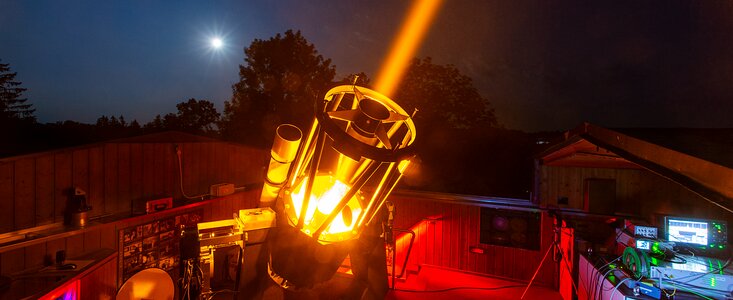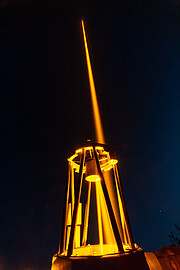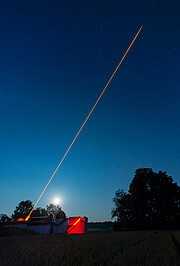Annuncio
Un nuovo potente laser basato su tecnologia dell'ESO supera i test sul campo
31 Agosto 2021
Un potente laser sperimentale, basato sulla tecnologia ESO, ha superato un test chiave il mese scorso all'osservatorio Allgäuer VolksSternwarte Ottobeuren in Germania. Il laser per l'ottica adattiva, sviluppato in collaborazione con l'industria, ha importanti capacità aggiuntive rispetto ai sistemi esistenti. Farà parte del sistema CaNaPy Laser Guide Star Adaptive Optics che sarà installato presso la Optical Ground Station dell’ESA (European Space Agency) a Tenerife, Spagna, nell'ambito della collaborazione ESO-ESA Ricerca & Sviluppo. La potenza maggiore del laser, quasi tre volte superiore a quella dei sistemi attuali, apre le porte a diversi sviluppi nella comunicazione laser satellitare così come a miglioramenti significativi nella nitidezza delle immagini astronomiche catturate con i telescopi da terra.
L'ottica adattiva astronomica si riferisce a sistemi su telescopi a terra che correggono l'effetto di sfocatura causato dalla turbolenza nell'atmosfera terrestre - lo stesso effetto che fa "scintillare" le stelle viste dalla Terra. Per rimuovere le distorsioni, questi sistemi richiedono una stella di riferimento luminosa vicino all'oggetto di studio. Poiché queste stelle non sono sempre collocate in modo conveniente nel cielo, gli astronomi usano il laser per eccitare gli atomi di sodio a 90 km di altezza nell'atmosfera terrestre, creando stelle artificiali vicino al campo di interesse che possono essere usate per mappare e correggere la turbolenza atmosferica.
Il nuovo laser sperimentale è basato sulla stessa tecnologia dell'ESO che ha portato al Four Laser Guide Star Facility, che opera con successo al VLT (Very Large Telescope) dell'ESO in Cile, così come nella maggior parte dei grandi osservatori astronomici del mondo. Ma mentre quei laser hanno una potenza di 22 Watt, questo nuovo laser ha un potenza quasi tripla, di 63 Watt, un enorme balzo in avanti nella tecnologia laser astronomica che, tra le altre cose, migliorerà la nitidezza delle immagini ottenute con l'ottica adattiva a lunghezze d'onda visibili. Come parte di un accordo di collaborazione R&S con l'ESO, la società canadese MPB Communications - uno dei partner industriali dell'ESO - è stata in grado di aumentare la potenza della sorgente infrarossa dell'amplificatore Raman a fibre. Questa è la scoperta che permette al laser CaNaPy dell'ESO di raggiungere una potenza così elevata [1].
Inoltre, la società tedesca TOPTICA Photonics AG, un altro dei partner industriali di ESO, ha sviluppato e implementato nel laser CaNaPy un sistema di chirping di frequenza per questa nuova classe di laser, come parte di un accordo di collaborazione R&S con l'ESO. Il chirping consiste nel cambiare rapidamente la frequenza alla quale il laser è sintonizzato. Questo aumenta il numero di atomi di sodio stimolati dal laser, rendendo più luminosa la stella artificiale e migliorando così la correzione della turbolenza. TOPTICA ha installato il prototipo di chirping sul laser da 63 Watts e, con l'ESO, ha collaudato in cielo sia il laser che il nuovo sistema di chirping.
Il nuovo laser sperimentale CaNaPy è un esempio di tecnologia astronomica sviluppata all'interno dell'ESO, in collaborazione con il settore industriale, e poi ritrasferita all'uso industriale anche in nuovi campi, trovando così applicazioni al di là del suo scopo originale e portando benefici alla società nel suo insieme. Una volta che lo strumento della struttura CaNaPy sarà installato presso la Stazione Ottica di Terra dell'ESA a Tenerife - un progetto di collaborazione tra l'ESO [2] e l'ESA - fornirà a entrambe le organizzazioni (ESA e ESO) l'opportunità di far progredire l'uso delle tecnologie di ottica adattiva delle stelle guida laser non solo per l'astronomia ma anche per la comunicazione ottica satellitare. La comunicazione ottica laser permette ai satelliti di inviare e ricevere segnali da e verso la Terra con una larghezza di banda ultra-veloce, una prospettiva che l'ESA sta studiando. I segnali laser ottici possono trasmettere molte più informazioni dei segnali radio, ma subiscono comunque gli effetti della turbolenza atmosferica. L'ottica adattiva delle stelle guida laser ha quindi il potenziale per migliorare notevolmente i collegamenti ottici tra i satelliti e le stazioni di terra.
Note
[1] MPB Communications ha aumentato la potenza del proprio amplificatore Raman a fibre, che opera nell'infrarosso a 1178 nm, dal livello di 36 Watt normalmente usato nei laser di guida al sodio commerciali a un livello senza precedenti di 100 Watt. Questo permette a CaNaPy di raggiungere una potenza d'onda continua di 63 Watt operando a 589 nm, nel visibile.
[2] La collaborazione include diversi istituti negli Stati Membri dell'ESO: l'Istituto Nazionale di Astrofisica in Italia, la Durham University nel Regno Unito e l'Instituto de Astrofísica de Canarias in Spagna.
Links
- Articolo su Messenger sullo sviluppo del laser per le stelle guida del laser al sodio all'ESO
- Progetto Hydron dell'ESA
- Allgäuer VolksSternwarte Ottobeuren
- MPB Communications
- TOPTICA Photonics AG
Contatti
Domenico Bonaccini Calia
Physicist in the Laser and Photonics Group at ESO
Garching bei München, Germany
Email: dbonacci@eso.org
Juan Carlos Muñoz Mateos
ESO Media Officer
Garching bei München, Germany
Email: jmunoz@eso.org
Riguardo all'annuncio
| Identificazione: | ann21011 |
Our use of Cookies
We use cookies that are essential for accessing our websites and using our services. We also use cookies to analyse, measure and improve our websites’ performance, to enable content sharing via social media and to display media content hosted on third-party platforms.
ESO Cookies Policy
The European Organisation for Astronomical Research in the Southern Hemisphere (ESO) is the pre-eminent intergovernmental science and technology organisation in astronomy. It carries out an ambitious programme focused on the design, construction and operation of powerful ground-based observing facilities for astronomy.
This Cookies Policy is intended to provide clarity by outlining the cookies used on the ESO public websites, their functions, the options you have for controlling them, and the ways you can contact us for additional details.
What are cookies?
Cookies are small pieces of data stored on your device by websites you visit. They serve various purposes, such as remembering login credentials and preferences and enhance your browsing experience.
Categories of cookies we use
Essential cookies (always active): These cookies are strictly necessary for the proper functioning of our website. Without these cookies, the website cannot operate correctly, and certain services, such as logging in or accessing secure areas, may not be available; because they are essential for the website’s operation, they cannot be disabled.
Functional Cookies: These cookies enhance your browsing experience by enabling additional features and personalization, such as remembering your preferences and settings. While not strictly necessary for the website to function, they improve usability and convenience; these cookies are only placed if you provide your consent.
Analytics cookies: These cookies collect information about how visitors interact with our website, such as which pages are visited most often and how users navigate the site. This data helps us improve website performance, optimize content, and enhance the user experience; these cookies are only placed if you provide your consent. We use the following analytics cookies.
Matomo Cookies:
This website uses Matomo (formerly Piwik), an open source software which enables the statistical analysis of website visits. Matomo uses cookies (text files) which are saved on your computer and which allow us to analyze how you use our website. The website user information generated by the cookies will only be saved on the servers of our IT Department. We use this information to analyze www.eso.org visits and to prepare reports on website activities. These data will not be disclosed to third parties.
On behalf of ESO, Matomo will use this information for the purpose of evaluating your use of the website, compiling reports on website activity and providing other services relating to website activity and internet usage.
Matomo cookies settings:
Additional Third-party cookies on ESO websites: some of our pages display content from external providers, e.g. YouTube.
Such third-party services are outside of ESO control and may, at any time, change their terms of service, use of cookies, etc.
YouTube: Some videos on the ESO website are embedded from ESO’s official YouTube channel. We have enabled YouTube’s privacy-enhanced mode, meaning that no cookies are set unless the user actively clicks on the video to play it. Additionally, in this mode, YouTube does not store any personally identifiable cookie data for embedded video playbacks. For more details, please refer to YouTube’s embedding videos information page.
Cookies can also be classified based on the following elements.
Regarding the domain, there are:
- First-party cookies, set by the website you are currently visiting. They are stored by the same domain that you are browsing and are used to enhance your experience on that site;
- Third-party cookies, set by a domain other than the one you are currently visiting.
As for their duration, cookies can be:
- Browser-session cookies, which are deleted when the user closes the browser;
- Stored cookies, which stay on the user's device for a predetermined period of time.
How to manage cookies
Cookie settings: You can modify your cookie choices for the ESO webpages at any time by clicking on the link Cookie settings at the bottom of any page.
In your browser: If you wish to delete cookies or instruct your browser to delete or block cookies by default, please visit the help pages of your browser:
Please be aware that if you delete or decline cookies, certain functionalities of our website may be not be available and your browsing experience may be affected.
You can set most browsers to prevent any cookies being placed on your device, but you may then have to manually adjust some preferences every time you visit a site/page. And some services and functionalities may not work properly at all (e.g. profile logging-in, shop check out).
Updates to the ESO Cookies Policy
The ESO Cookies Policy may be subject to future updates, which will be made available on this page.
Additional information
For any queries related to cookies, please contact: pdprATesoDOTorg.
As ESO public webpages are managed by our Department of Communication, your questions will be dealt with the support of the said Department.



